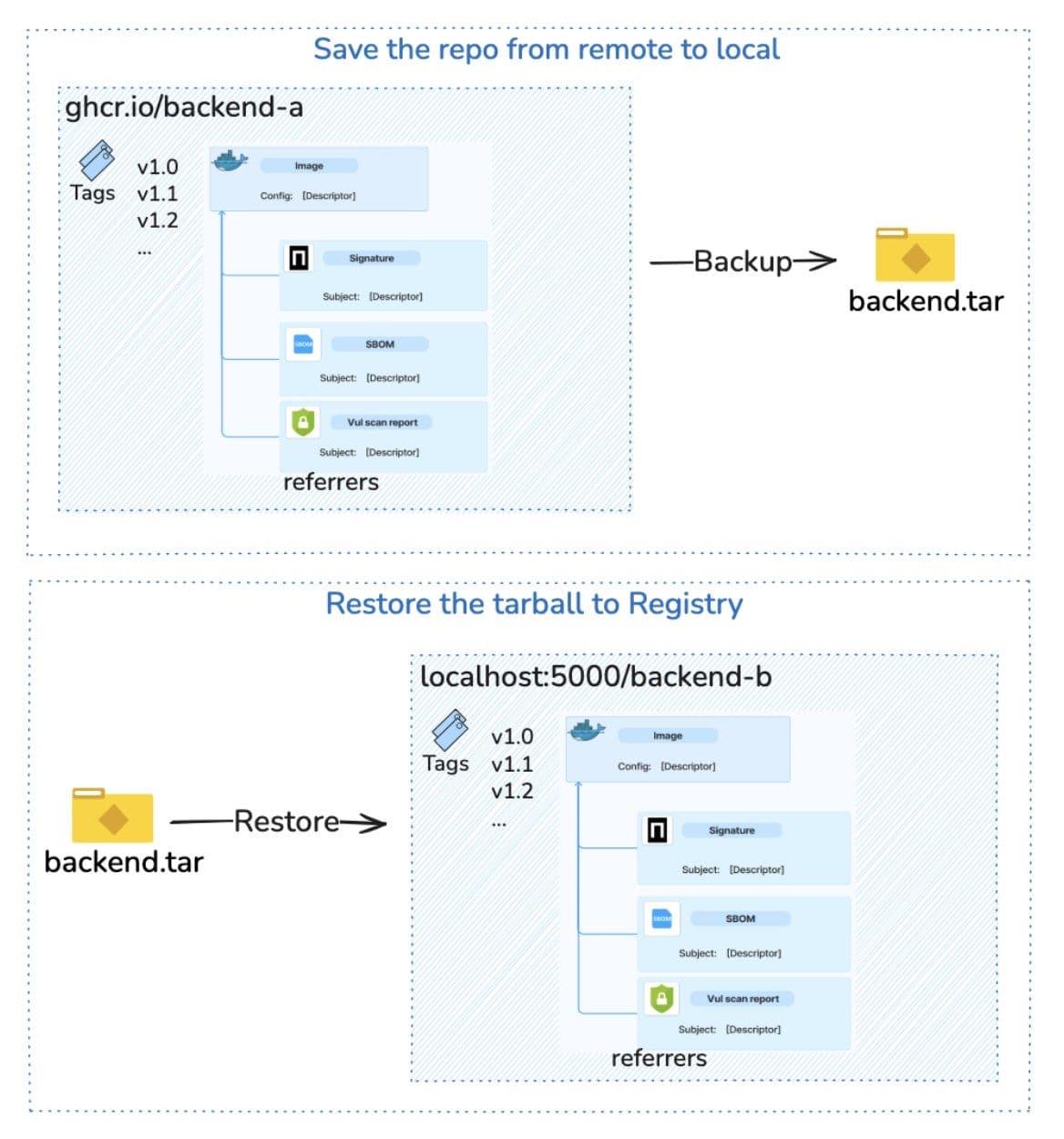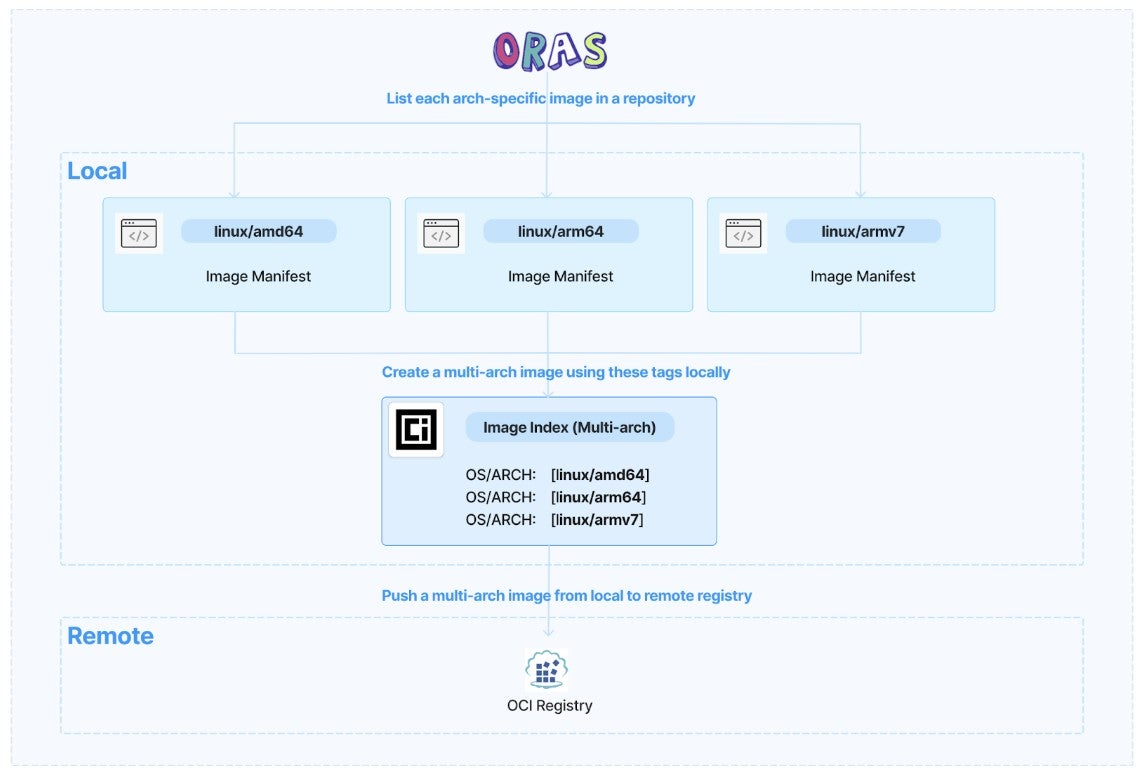The ORAS community is thrilled to announce the release of ORAS CLI v1.3.0, a version packed with stability improvements and pioneering capabilities. In addition to strengthening existing functionality, this release introduces three major new features designed to enhance artifact and registry management workflows:
- Portable backup and restore of repositories and artifacts
- Multi-platform image and artifact management
- Rich formatted output for scripting and pipelines
Moreover, ORAS is now fully compliant with OCI distribution-spec v1.1.1.
Your registry’s safety net: Portable backup & restore
With oras backup and oras restore, ORAS now lets you save your registry content into local directories or tarballs (OCI image layout format) as a snapshot and restore to any registry. All manifests, along with any optional tags and referrers, will be included in the backup.
Use cases include:
- Air-gapped environments: Organizations operating in isolated or high-security environments can use oras backup to export artifacts from a registry to the local filesystem, and oras restore to import them into an internal registry with restricted access.
- Disaster recovery and audit archival: Take periodic snapshots of repositories and store them off-site. In case of accidental deletions, outages, or long-term storage for regulatory audits, oras restore can quickly recover full registry content.
- Registry migration: When moving from one container registry provider to another, these commands enable a full repository export, preserving tags, manifests, layers, and referrers.
- Compliance and supply chain security: Back up and restore images along with their supply chain artifacts, such as SBOMs, signatures, and vulnerability scanning reports.
- Repository duplication or promotion: Move artifacts from dev to staging to production registries reliably using an intermediate backup file.
Check out the user guide Backup and Restore of OCI Artifacts, Images, and Repositories for details.

Multi-platform image and artifact management
Multi-platform images are commonly used in IoT and Edge computing, particularly in heterogeneous deployments. In addition, OpenTofu or Terraform modules are often packaged as platform-specific artifacts and stored as multi-platform artifacts in OCI registries. Thanks to our community partner OpenTofu, multi-platform artifact management is now introduced in v1.3.0.
With oras manifest index create and oras manifest index update, you can easily assemble, update, distribute, and annotate multi-architecture images and artifacts across local environments and registries.
Check out the user guide Create and Manage Multi-architecture Artifacts for details.

Enable scripting and automation: Formatted output
In automation pipelines, the difference between human-readable and machine-usable output can be critical.
With this release, ORAS enables users to use the –format flag to output metadata in structured data (e.g., JSON) and optionally the –template flag with the Go template language. This has been enabled for commands like pull, push, attach, discover, and manifest fetch with support for formats including JSON, Go templates, trees, and tables. You can even run computations with Sprig template functions.
- Use –format <DATA_FORMAT> to transform the output of ORAS commands into formats including prettified JSON, tree, table view, and Go template (–format json|tree|table|go-template=GO_TEMPLATE).
- Use –template GO_TEMPLATE to compute and manipulate the output using Go templates based on the chosen data format.
Formatted output transforms ORAS from a simple terminal tool into a DevOps-friendly, integrable developer tool. Check out the user guide Formatted Output for details.
Stability & user experience polish
This release also includes a number of enhancements that provide better overall stability and user experience.
- Feature stability promotions: oras attach, oras pull –include-subject, and more are now Stable. oras resolve has moved from Experimental to Preview.
- Discover UX: oras discover now displays referrers recursively by default. The maximum recursion depth can be controlled via the –depth flag.
- Loong64 support: More platform options, including loong64, are now available.
- Developer experience: Improved clarity in error messages, debugging logs, and numerous documentation updates.
Why this release matters
Whether you’re looking to back up and restore entire registries, publish multi-architecture bundles, or integrate ORAS into CI/CD pipelines, v1.3.0 brings the tools and end-to-end artifact management solutions you need.
- Platform teams gain robust disaster recovery and migration tooling.
- DevOps engineers benefit from multi-arch flexibility for heterogeneous infrastructure.
- CI/CD and platform builders leverage structured data outputs for reliable, scriptable workflows.
- Maintainers deliver safer, cleaner, and more future-proof artifact workflows.
There are also a few bug fixes and a deprecated feature in this release. For a detailed changelog, please see the [ORAS v1.3.0 Release Notes].
Thanks to all contributors
Thanks to our existing maintainers @Wwwsylvia, @TerryHowe, @FeynmanZhou, @shizhMSFT, @sabre1041, @sajayantony, @qweeah who contributed to ORAS v1.3.0 and new contributors 🎉 @bcho, @njucjc, @nmiyake, @mauriciovasquezbernal, @Horiodino, @chrisguitarguy, @kysucix, @RohanMishra315, @apparentlymart, @tanyabhatnagar, @amazingfate 🚀.
You can follow the installation guidance to install ORAS v1.3.0 and try it out yourself. End-user feedback is essential in any open source project. If you run into issues or have suggestions, please open an issue. To engage with the community, join the CNCF Slack and find us in the #oras channel.